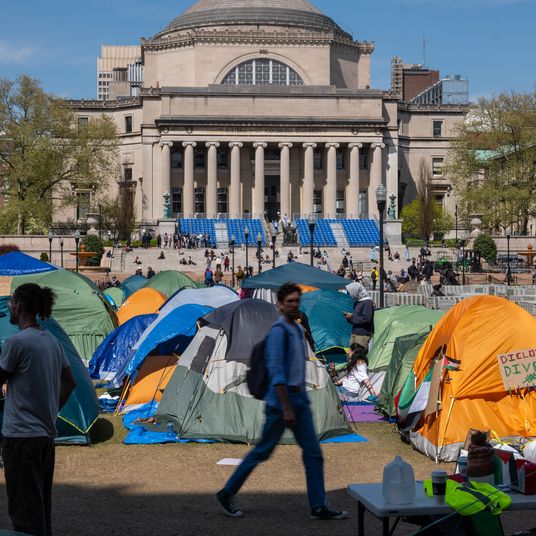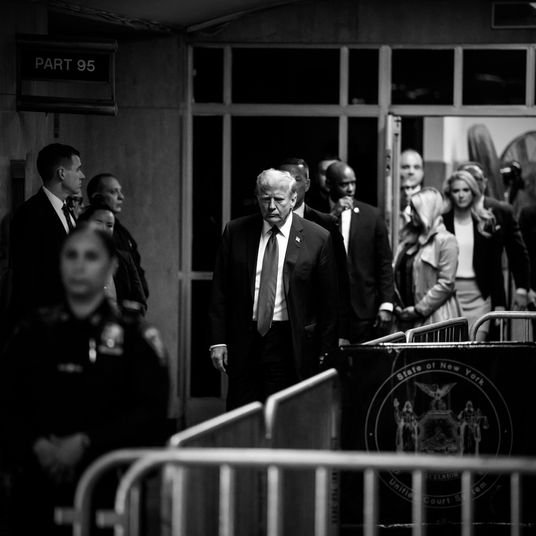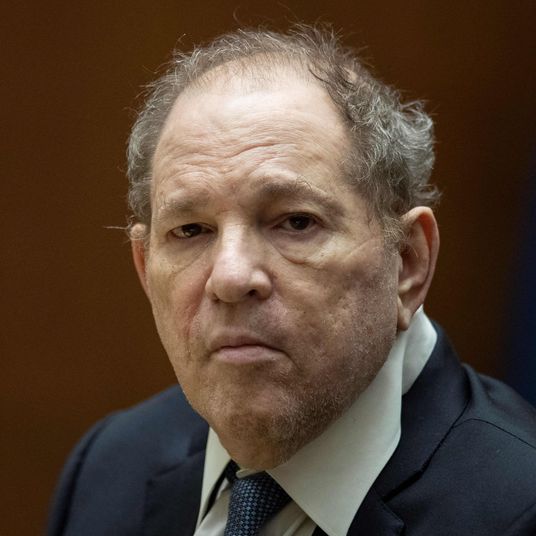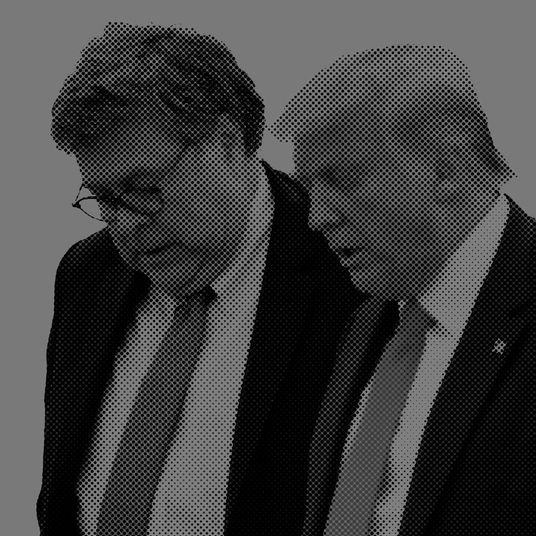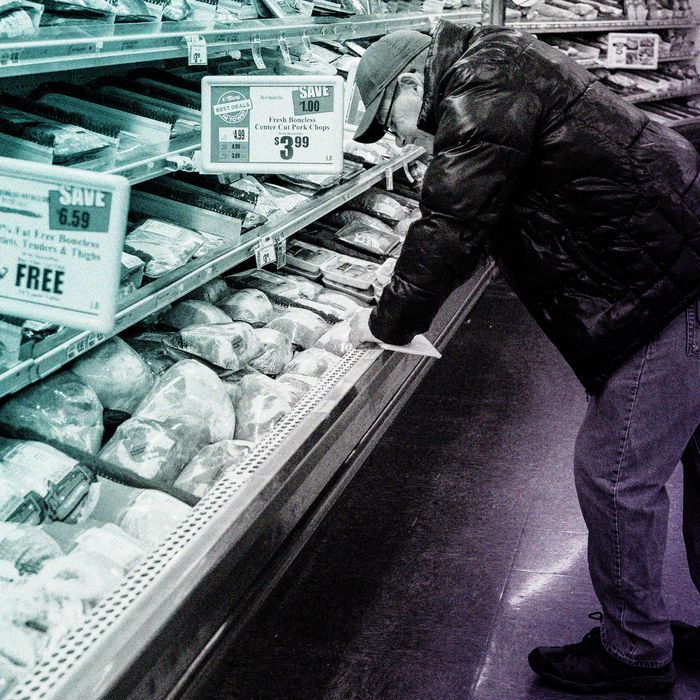
Is the U.S. economy any good right now? This seemingly straightforward question is not such an easy one to answer. Yes, unemployment is low, post-COVID inflation’s worst days are well behind us, and the Federal Reserve is now predicting a solid 2 percent growth rate this year. Then again, stubbornly high prices for food and homes continue to bedevil Americans looking for stability. Joe Biden has managed to avoid what looked like an all-but-certain recession so far, but whether voters will reward him for that in November is far less clear.
Mark Zandi is the influential chief economist at Moody’s Analytics, where he and his team oversee a kind of war room for financial and economic data, tracking the way Americans feel about the economy. In January, Zandi put out a report calling the race for Biden — at least, as long as the economy doesn’t tank the rest of the year. But since then, inflation, which had appeared to be on a steeply downward trajectory, has once again proven stickier than anticipated. I recently spoke with Zandi about the gap between favorable economic indicators and the reality voters live in, and how it will shape the presidential election.
At the top of your January report, you say that the election hinges on the strength of the economy between now and Election Day. Is this election more dependent on the economy than previous ones?
No. The economy is always important. There might be some exceptions when we get pandemics and wars, but for the most part, I think the economy is topic number one for most people. Right now, voters are looking at the economy to their own financial position, and what they see determines in large part how they vote.
As a general matter, who is more motivated to vote? People who are feeling well-off, or those who feel like they’re being left behind?
In general, people who are dissatisfied, uncomfortable with their financial position, are more likely to vote against the incumbent party. If things aren’t going well for them financially, if they don’t have a job or their purchasing power has been undermined or they’re having trouble making ends meet or making the medical payment, they’re going to blame whoever is at the till, whoever is ostensibly running the economy.
In your analysis from January, you said that, short of a recession, you would expect Biden to win. But we’ve seen that a lot of people have been thinking that we’re in a recession, even though we’re not.
You’re right — perceptions are ultimately the critical determining factor. The economy, based on the numbers, could be as good as it gets, but it doesn’t really matter unless people believe it. It’s really how people feel about their personal financial situation, and that’s a different kettle of fish. That’s why I think this election is going to be as close as it is, because if it was just based on the numbers, Biden should win hands down, but he’s not going to.
The culprit here is inflation. People really have gotten unnerved by the higher prices they’ve had to pay, mostly for staples. Food is at the top of the list, and then rent, the cost of housing. Those are the things that really matter a lot. Gas prices would matter, also, if they started to rise. If they start pushing higher and go up another half a buck, a buck, then that’s also going to be on the list.
When you’re analyzing inflation and wages, do you look at that on a national level, or state by state?
State by state. The modeling work we do is based on the Electoral College, so we’re remodeling at a state level. So, one of the key variables is real household income — it’s real after inflation.
In swing states like Nevada, Pennsylvania, North Carolina, Georgia — what does real income look like? Are people making more than the inflation rate?
They are. Over the past year, real household incomes have been steadily rising. Wage gains are stronger than the rate of inflation. Of course, real wages fell in 2022 and early 2023, so much of this recent increase over the past year is basically catching up.
We’ve got another few months to go. If these trend lines continue, and we expect they will, perceptions will be close enough to reality to push Biden over the top in those four of the five key swing states that are within a percentage point.
The state that matters the most, by far, is Pennsylvania. That’s key. And the Pennsylvania economy is okay. It’s not, you know, Georgia-like. It’s not Arizona. It’s not on par with those economies. But it’s okay. That makes the election feel even closer because it’s just okay. You know, it’s not rip-roaring.
Do you mean that Georgia, Nevada, and Arizona’s economies are doing very well?
Yeah. Of the five swing states, four of them are doing well. It’s Pennsylvania that’s in the middle of the pack.
What is it about Pennsylvania that is holding it back compared to other states?
It’s partly demographic. Pennsylvania is actually an older state, and is a bit of a casualty from a remote-work dynamic. Philadelphia and Pittsburgh have made significant strides in doing well, by Pittsburgh and Philly standards.
One thing that limits the outflows of people, interestingly enough, is that the state does not tax social-security benefits. Retirees, generally lower-income, stick around in the state to avoid paying sales tax.
So is there a catch when it comes to inflation and electoral politics — where if people are feeling good about the economy, then they are less motivated to vote, so the real goal is just to tamp down on the people who would be voting against you, rather than pumping up the numbers of people who want to vote for you?
There’s some truth to that. It’s really about those independent voters that are kind of on the margin in a few swing states, and really in a few swing counties. That’s one of the things I kind of came away with. We basically elect a president based on six, ten counties across the country. It’s really about turnout in those counties. Will the Democrats in Philadelphia turn out? The Republicans in Pinellas County [in Florida]? Or the Democrats in DeKalb County and Atlanta? That’s really what matters in terms of the election, how motivated they are.
Have you drilled down on those counties, to see how well they’re doing economically?
Yeah, again, those are the big counties generally in those states, and they tend to mirror the state. They’re doing okay. Philadelphia and Pittsburgh are doing reasonably well, better than the rest of the state, and that may favor Biden as well.
Take Philadelphia. I live in the Philadelphia region, in Chester County. Philadelphia is actually doing well because it’s got a lot of eds and meds — a lot of universities and hospitals. Those industries are doing very well, and that’s driving a lot of economic activity. And I had to say, I grew up in Philadelphia, I’ve never seen the city as vibrant as it is today. Despite the outflows, you’ve got a lot going on here.
There’s a ton of data that you must be taking in — not only the economic data, but the voting data from primaries and caucuses. Are you able to glean anything from the votes so far, either from Republicans or Democrats?
In our modeling, we account for economic factors and political factors. And the key political factor is turnout — can you get your voters to go to the polls? And that goes right back to enthusiasm. And it appears that Trump’s voters are more enthusiastic than Biden’s voters, at least at this point in time.
When it comes to inflation, obviously, the big thing to watch is the Fed’s interest rate. Markets seem to think the Fed won’t cut until July, which would mean a maximum of two cuts prior to the election. Do you think that outcome would make a difference in the election?
It can’t hurt. For every rate cut, you’ll see a decline in interest rates on credit cards, on buy-now-pay-later loans, probably on auto loans. So it would provide some relief. It would be mostly on the margin.
The interest rate that matters the most is the 30-year fixed-rate mortgage right. And in all likelihood, those rate cuts will not impact that. That’s determined by long-term interest rates. The Fed influences it through expectations that are embedded, so the fact the markets expect two rate cuts, quarter-point each by the end of the year, is already reflected in the current mortgage rates.
It would also come fairly late for the housing market.
Yeah, exactly. If it came in July, as markets anticipate, by the time it showed up in sales, it would probably be beyond the point where it really mattered to most people.
It’s all about expectations. If people see rates coming in, and markets are expecting rates to come down further, people could take that into consideration. Trend lines matter to people, because they’re doing a forecast, and they’re going to be using what happened recently to do the forecast.
It’s these little things on the margin that may actually decide who wins this thing. It’s going be that close.
This interview has been edited for length and clarity.
More of the Money Game
- Can Elon Musk Pull Off a Mark Zuckerberg?
- Everything We Know About Donald Trump’s Wild Civil Bond Saga
- Why Joe Biden Really, Really Wants Lower Interest Rates






